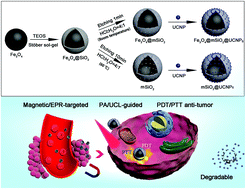Degradable magnetic-response photoacoustic/up-conversion luminescence imaging-guided photodynamic/photothermal antitumor therapy†
Abstract
In this research, a degradable uniform mesoporous platform was designed as an imaging-guided photothermal therapy (PTT)/photodynamic therapy (PDT) agent. Fe3O4 nanoparticles were prepared using the solvothermal method, and a layer of mesoporous SiO2 was coated onto them using sol–gel and etching processes, then these ultra-small up-conversion nanoparticles (UCNPs) were loaded into the porous structure through electrostatic conjunction and physical absorption. By adjusting the etching processes, Fe3O4@mSiO2 and mSiO2 with a high surface area as a carrier host could be obtained separately. Importantly, the platform could recognize the tumor cells with a magnetic-response and then present strong photoacoustic (PA) and up-conversion luminescence (UCL) signals, and Fe3O4@mSiO2 as drug carriers could be degraded by hydrolysis. Furthermore, under a single 808 nm laser, the temperature of Fe3O4@mSiO2@UCNPs rises much higher than that of the surrounding tissues, and produces a large amount of singlet oxygen because a strong crossover occurs between the emitted blue emission of the UCNPs and the absorbance region of Fe3O4. Therefore, the Fe3O4@mSiO2@UCNPs can be used as a magnetic-targeted dual-modal imaging guided PTT/PDT theranostic probe.



 Please wait while we load your content...
Please wait while we load your content...